|
|
|
Sort Order |
|
|
|
Items / Page
|
|
|
|
|
|
|
| Srl | Item |
| 1 |
ID:
119758
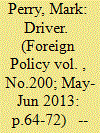

|
|
|
| 2 |
ID:
122591


|
|
|
|
|
| Publication |
2013.
|
| Summary/Abstract |
Nine days after the victory in the Six Day War the Israeli cabinet adopted a resolution which seemingly offered Egypt and Syria the territories they had just lost in exchange for contractual peace. In public and academic discourse the resolution has been presented as a 'generous peace offer' which was transmitted to Cairo and Damascus through the United States and was immediately rejected. The article demonstrates that the 'generous peace offer' was never offered to the Arabs. The cabinet resolution was mainly a diplomatic manoeuver whose aim was to gain American political support against a Soviet move at the United Nations for immediate and unconditional Israeli withdrawal from the territories occupied in the war. The article argues that Abba Eban, Israel's foreign minister at the time, created the myth of the 'generous peace offer' and that it has been turned into an accepted wisdom by dozens of writers and scholars who have recycled Eban's story unchallenged.
|
|
|
|
|
|
|
|
|
|
|
|
|
|
|
|
| 3 |
ID:
158158
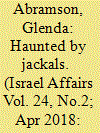

|
|
|
|
|
| Summary/Abstract |
In 1917, towards the end of the First World War, the Ottoman Governor of the Levant, Jamal Pasha, ordered the expulsion of the communities of Jaffa and Tel Aviv, ostensibly for their safety. Moving northwards to the Lower Galilee, the Jewish deportees’ actual experiences were severe and traumatic, with many instances of great suffering, illness and death. A series of other, smaller, but no less deadly, expulsions began in the winter of 1917 following the NILI affair. In November 1917, several groups, mainly of Jews, primarily those suspected of an association with NILI, were imprisoned in Jerusalem, then moved to prisons in Damascus on foot or by train. The deportees included the Arab educationist Khalil Sakakini, and two Jews who later became prominent in the Zionist movement, N. Twersky and Yitzhak Livni. After an introduction describing the expulsion from Jaffa, this article describes the forced marches and imprisonment endured by Twersky, Sakakini, and Livni, based on their diaries.
|
|
|
|
|
|
|
|
|
|
|
|
|
|
|
|
| 4 |
ID:
108520
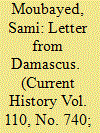

|
|
|
| 5 |
ID:
115074
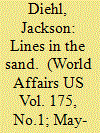

|
|
|
|
|
| Publication |
2012.
|
| Summary/Abstract |
On March 6, 2011, a group of fifteen schoolboys in the southern Syrian town of Daraa were arrested by local security forces. Aged ten to fifteen, the boys were caught spray-painting the slogan "As Shaab Yoreed Eskaat el nizam!"-"The people want to topple the regime!" They had taken the words from satellite television coverage of the uprisings in Tunisia and Egypt.
|
|
|
|
|
|
|
|
|
|
|
|
|
|
|
|
| 6 |
ID:
100343
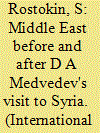

|
|
|
|
|
| Publication |
2010.
|
| Summary/Abstract |
ON MAY 11, 2010, the temperature in Damascus was significantly higher than average. Nevertheless, 37 degrees Celsius did not affect the program of the Russian president's visit. As planned, D.A. Medvedev and Bashar Assad met in the afternoon on the main street of the "old town,'' known two millennia ago as Via Recta.
From the place where the historical street reaches the Eastern Gate (Bab Sharqi), the Russian and Syrian presidents walked to the St. Ananias Chapel. In a narrow side street, packed with antique shops and restaurants, people were coming out from their apartments on upper floors to greet D.A. Medvedev and B. Assad. The atmosphere was extremely relaxed and informal.
It was the first time that the presidents communicated with each other, without a translator, on common topics. B. Assad told his guest about the unique history of old Damascus, the oldest capital in the modern world. The walk probably became the culmination of the visit, emphasizing the remarkable level of personal trust that the two countries' leaders had achieved in their relations.
|
|
|
|
|
|
|
|
|
|
|
|
|
|
|
|
| 7 |
ID:
175144


|
|
|
|
|
| Summary/Abstract |
The renowned Syrian ʿālim Shaykh Muhammad Sa’id Ramadan Al-Buti was one of the world's leading scholarly representatives of Sunni Islam in contemporary times. The written debates that occurred between the Damascene ʿulamā’, al-Buti, and the iconic Salafi scholar and ḥadīth scholar Muhammad Nasir al-Din al-Albani constitute one of the most important and comprehensive intra-Muslim debates in the twentieth century, having helped to define a clear schism between the neo-traditionalist position and its presumed opposite: Salafism. This article suggests that the rhetoric of anti-Salafism needs to be studied further to better understand contemporary currents in modern Islamic intellectual history. The adversarial rift that crystallised in the thriving Shāmī scholarly milieu of the 1980s and 90s informed the existence of a distinct neo-traditionalist school both in the West and many parts of the Muslim world for the latter part of twentieth century and to this day. At the intersection of political competition, textual methodology and competing visions of heresy and history, Islamic neo-traditionalism represents a key contestant in the battle for religious authority in contemporary Islam under the secular nation-state. Between championing a constructed concept of a ‘tradition’ for modern times and those who seek to return to a pristine ‘true Islam’, a deadlock is inevitable.
|
|
|
|
|
|
|
|
|
|
|
|
|
|
|
|
| 8 |
ID:
111233


|
|
|
|
|
| Publication |
2012.
|
| Summary/Abstract |
The Palestinian Right of Return Movement (RoRM) emerged among diaspora refugee communities following the Oslo accords and the perceived threat to the right of return. This article focuses on the RoRM in Syria in the context of the community's history and unique civil rights there. Based on extensive interviews in the Damascus area, it provides an overview of the heterogeneous movement, which, while requiring state approval, operates in an autonomous civil society sphere. RoRM activists translate visions of the return formulated in the Palestinian national arena into local community practices that mobilize memories of Palestine as resources (through oral history, village commemorations, etc.) with the aim of ensuring a future return by the new generation of refugees.
|
|
|
|
|
|
|
|
|
|
|
|
|
|
|
|
| 9 |
ID:
108639


|
|
|
|
|
| Publication |
2011.
|
| Summary/Abstract |
This article deals with the impact on the political forces in the Arab World in general and in Syria in particular of the free, democratic and peaceful accession to power of the Justice and Development Party in Turkey. It further examines how Syrian political movements, especially political Islam, are trying to make sense out of these recent "revolutionary" political developments in Turkey and how they can be applied to the Syrian case.
|
|
|
|
|
|
|
|
|
|
|
|
|
|
|
|
| 10 |
ID:
137958


|
|
|
|
|
| Summary/Abstract |
During the cold war period, the Middle East remained a region of contention between the United States and the Soviet Union because of its rich natural energy reserves and strategic location linking there continents: Asia, Africa and Europe
|
|
|
|
|
|
|
|
|
|
|
|
|
|
|
|
| 11 |
ID:
092494
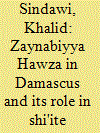

|
|
|
|
|
| Publication |
2009.
|
| Summary/Abstract |
The purpose of the present article is to examine the system of Shi'ite religious instruction in the Zaynabiyya awza in Damascus. As background we discuss the historical development which brought about the establishment of Shi'ite awzas and the evolution of Shi'ism in Syria. We analyze the reasons for the founding of the Zaynabiyya awza in Damascus, the causes of its great success, conditions for acceptance to the awza, the number of students, classrooms, teaching methods, the schedule, the language of instruction, official vacations and breaks, sources of financial support, stages of instruction and the curriculum of each stage, projects associated with the awza, the administrative building, the services it provides for its students, the awza's prospects for the future, its political role, and the Zaynabiyya awza's distinctive features in comparison to other Shi'ite institutions of the same kind.
|
|
|
|
|
|
|
|
|
|
|
|
|
|
|
|
|
|
|
|
|